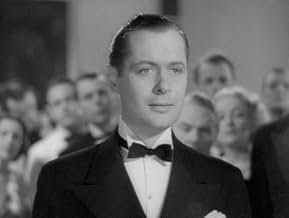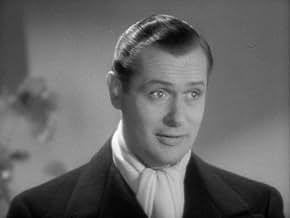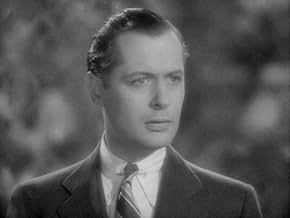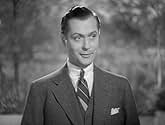IMDb-BEWERTUNG
6,0/10
989
IHRE BEWERTUNG
Füge eine Handlung in deiner Sprache hinzuA society girl tries to reform her playboy husband by making him jealous.A society girl tries to reform her playboy husband by making him jealous.A society girl tries to reform her playboy husband by making him jealous.
- Auszeichnungen
- 3 wins total
Charles Ruggles
- Edgar
- (as Charlie Ruggles)
Joan Fontaine
- Caroline
- (as Joan Burfield)
John David Horsley
- Duffy
- (as David Horsley)
E.J. Babille
- Desk Clerk
- (as E.J. Babiel)
Jean Acker
- Nightclub Extra
- (Nicht genannt)
Gertrude Astor
- Nightclub Extra
- (Nicht genannt)
Clem Beauchamp
- Drunk
- (Nicht genannt)
Brooks Benedict
- Joe Williams - Bar Owner
- (Nicht genannt)
Veda Buckland
- Marcia's Maid
- (Nicht genannt)
Empfohlene Bewertungen
Though the careers of Robert Montgomery, Joan Crawford, and her husband at the time, Franchot Tone's respective careers were not hurt by films like No More Ladies, this was the kind of stuff all three of these players were looking to get out of.
There was a truism at MGM back in its heyday. For films where the men wear tuxedos you first get Robert Montgomery. If he turns it down get Franchot Tone. If it's bad enough for Tone to turn it down God help him, Robert Young is stuck with it. So knowing the pecking order and knowing the billing, you can guess who Crawford winds up with.
Robert Montgomery plays another of those irrepressible womanizing playboys who's sowed enough wild oats to qualify for a farm subsidy. He's decided to settle down with society girl Joan Crawford who has certain ideas about infidelity and how wrong it is. Montgomery behaves at first, but when he uses their perpetually inebriated friend Charlie Ruggles as an alibi that doesn't hold up, Crawford decides on some revenge with Franchot Tone.
No More Ladies is harmless enough and when Edna May Oliver as Joan's grandmother is on the screen, always entertaining. But it was the stuff that MGM was grinding out in its dream factory. It was a case of Montgomery and Tone look great in tuxedos so cast them as urban playboys.
Well, both of them did look great, Louis B. Mayer wasn't wrong about that.
There was a truism at MGM back in its heyday. For films where the men wear tuxedos you first get Robert Montgomery. If he turns it down get Franchot Tone. If it's bad enough for Tone to turn it down God help him, Robert Young is stuck with it. So knowing the pecking order and knowing the billing, you can guess who Crawford winds up with.
Robert Montgomery plays another of those irrepressible womanizing playboys who's sowed enough wild oats to qualify for a farm subsidy. He's decided to settle down with society girl Joan Crawford who has certain ideas about infidelity and how wrong it is. Montgomery behaves at first, but when he uses their perpetually inebriated friend Charlie Ruggles as an alibi that doesn't hold up, Crawford decides on some revenge with Franchot Tone.
No More Ladies is harmless enough and when Edna May Oliver as Joan's grandmother is on the screen, always entertaining. But it was the stuff that MGM was grinding out in its dream factory. It was a case of Montgomery and Tone look great in tuxedos so cast them as urban playboys.
Well, both of them did look great, Louis B. Mayer wasn't wrong about that.
Broadway must have had dozens of these drawing room comedies featuring rich, well-dressed people speaking snappily to one another. I say "must have" because Hollywood seems to have adapted all of them. "No More Ladies" is yet another one, and for my money, it's pretty routine. Joan Crawford is a rich girl in love with a cad, played by Robert Montgomery. They marry and he's still a cad. In fact, instead of going to their country house one weekend, he delays his trip and has a dalliance with a woman named Therese. He admits this when he finally shows up in the country. He has little choice when he learns that his alibi, Charlie Ruggles, is actually at the country home. In retaliation, Crawford invites an old beau and a couple of ex-girlfriends to a huge party.
The dialogue is witty, the clothes are glamorous, the apartment and house are sumptuous, and the performances are very good. Montgomery was always perfect in these roles, and Crawford is attractive and spars with Montgomery well. Edna Mae Oliver is superb as always. Charles Ruggles plays a somewhat annoying drunk. Gail Patrick, who became Gail Patrick Jackson and produced "Perry Mason," having married Erle Stanley Gardner's agent, does very well as the pretty other woman.
This is one of those films where one asks, so why wasn't I crazy about it? The only reason is that there was a sameness about it and nothing really to differentiate it - including the cast - from all the other light, romantic comedies. It's no wonder that Robert Montgomery fought so hard to make "Night Must Fall." He was incredibly bored with these roles. It's understandable.
The dialogue is witty, the clothes are glamorous, the apartment and house are sumptuous, and the performances are very good. Montgomery was always perfect in these roles, and Crawford is attractive and spars with Montgomery well. Edna Mae Oliver is superb as always. Charles Ruggles plays a somewhat annoying drunk. Gail Patrick, who became Gail Patrick Jackson and produced "Perry Mason," having married Erle Stanley Gardner's agent, does very well as the pretty other woman.
This is one of those films where one asks, so why wasn't I crazy about it? The only reason is that there was a sameness about it and nothing really to differentiate it - including the cast - from all the other light, romantic comedies. It's no wonder that Robert Montgomery fought so hard to make "Night Must Fall." He was incredibly bored with these roles. It's understandable.
You've seen it all before, folks--another tiresome romantic comedy, unredeemed by an accomplished cast and the trademark MGM gloss. Joan Crawford is especially wasted in the airy proceedings; her dramatic intensity has no outlet here, and she is forced to rely on her lesser skills as a sophisticated comedienne. This is Carole/Claudette/Irene territory, and, although Joan can give these ladies cards in spades when it comes to glamour, she lacks their lighter touch. I suspect two forces were at work here: the Production Code of 1933, which forced out earthy drama and bawdy comedy and pushed stars like Harlow and Crawford into fluff, and the "Norma" syndrome at MGM, which forced Crawford to take Norma's castoff parts. (No wonder Joan ended up "box-office poison" shortly after pictures like this alienated her fan base!) If you'd like to see Joan in comedies more suited to her persona, check out her splendidly bitchy Crystal in "The Women", or as the clueless Susan in "Susan and God".
Since I like both Robert Montgomery and Franchot Tone, and I also like Joan Crawford better when she's younger, it was an easy guess that I'd like the romantic comedy No More Ladies. As it turned out, the film was far more of a drama than I thought, but the biting quips kept flying often enough to qualify it as a dark comedy.
Joan starts the film hopelessly in love with Robert Montgomery. He's handsome and enormously charming and can talk his way out of any mistake, whether it's tardiness or infidelity. Joan knows exactly what type of cad he is and yet she wants to marry him anyway. After they're married, she expects him to keep his roving eye in check, but he doesn't. Depending on whether or not you like Robert Montgomery will probably be the deciding factor for you as to whether or not you like the overall film. If you think he's a terrible cad who has no excuse of losing his will-power whenever a skirt walks past, you'll want Joan to go to Reno and get over him. If you think he has appallingly low self-control but really does love his wife and just needs to be watched like a puppy, you won't want her to drive to Reno. You might want her to team up with her supportive grandmother, Edna May Oliver, and throw a party akin to A Little Night Music or Smart Woman. You might want her to use her handsome friend Franchot Tone to make her husband jealous. It's a little eerie to watch Joan and Franchot's scenes together since this movie was made before they were married and most of Franchot's dialogue consists of bitter complaints about his ex-wife. However, they're both young and pretty, and it's nice to see them during happier times. It's also nice to see Joan's beautiful dresses, designed by the very talented Adrian.
Joan starts the film hopelessly in love with Robert Montgomery. He's handsome and enormously charming and can talk his way out of any mistake, whether it's tardiness or infidelity. Joan knows exactly what type of cad he is and yet she wants to marry him anyway. After they're married, she expects him to keep his roving eye in check, but he doesn't. Depending on whether or not you like Robert Montgomery will probably be the deciding factor for you as to whether or not you like the overall film. If you think he's a terrible cad who has no excuse of losing his will-power whenever a skirt walks past, you'll want Joan to go to Reno and get over him. If you think he has appallingly low self-control but really does love his wife and just needs to be watched like a puppy, you won't want her to drive to Reno. You might want her to team up with her supportive grandmother, Edna May Oliver, and throw a party akin to A Little Night Music or Smart Woman. You might want her to use her handsome friend Franchot Tone to make her husband jealous. It's a little eerie to watch Joan and Franchot's scenes together since this movie was made before they were married and most of Franchot's dialogue consists of bitter complaints about his ex-wife. However, they're both young and pretty, and it's nice to see them during happier times. It's also nice to see Joan's beautiful dresses, designed by the very talented Adrian.
In the past 24 hours, I watched two 1930s comedies -- MERRILY WE LIVE and NO MORE LADIES.
IDMB users seemed to like MWL far more than I did. Many of the actors brought little to their roles in that film, and there's not a snappy bit of dialogue in the whole picture.
NML, on the other hand, is very witty, very well-acted, and quite entertaining. Yes, it might have been even better with someone other than Joan Crawford in the female lead, but Robert Montgomery is very strong and this was the most enjoyable work I'd ever seen Edna May Oliver deliver.
And I don't think, as one reviewer suggested, the Code impacted this movie very much -- in fact, it comes as being quite Pre-Code in nature. If you didn't know when it was made, one might easily guess it was pre-, not post-, code.
In short, not a classic, but quite snappy and entertaining and well worth watching.
IDMB users seemed to like MWL far more than I did. Many of the actors brought little to their roles in that film, and there's not a snappy bit of dialogue in the whole picture.
NML, on the other hand, is very witty, very well-acted, and quite entertaining. Yes, it might have been even better with someone other than Joan Crawford in the female lead, but Robert Montgomery is very strong and this was the most enjoyable work I'd ever seen Edna May Oliver deliver.
And I don't think, as one reviewer suggested, the Code impacted this movie very much -- in fact, it comes as being quite Pre-Code in nature. If you didn't know when it was made, one might easily guess it was pre-, not post-, code.
In short, not a classic, but quite snappy and entertaining and well worth watching.
Wusstest du schon
- WissenswertesBig-screen debut of Joan Fontaine (listed as Joan Burfield).
- PatzerWhen Sherry and Fanny are talking in front of the fireplace, from one scene to the next his position changes back and forth. First he's standing and facing Fanny, who is sitting as they talk; then he is to her side, kneeling on a sofa bench with his back to her and leaning on the fireplace hearth. Then he is back opposite her, standing and facing her as they talk; then he's back kneeling on the sofa and leaning on the hearth. Then he's once again standing and facing Fanny.
- Zitate
Oliver Allen: Look here, you can't go up there--she might be in bed!
Sheridan 'Sherry': Since when has a lady in bed been an object of repugnance?
- VerbindungenFeatured in Joan Crawford: The Ultimate Movie Star (2002)
- SoundtracksAll I Do Is Dream Of You
(1934) (uncredited)
Music by Nacio Herb Brown
Lyrics by Arthur Freed
Played on banjo by Arthur Treacher and
Sung by Gail Patrick at the party
Top-Auswahl
Melde dich zum Bewerten an und greife auf die Watchlist für personalisierte Empfehlungen zu.
Details
- Erscheinungsdatum
- Herkunftsland
- Sprache
- Auch bekannt als
- No More Ladies
- Drehorte
- Produktionsfirma
- Weitere beteiligte Unternehmen bei IMDbPro anzeigen
Box Office
- Budget
- 765.000 $ (geschätzt)
- Laufzeit1 Stunde 20 Minuten
- Farbe
- Seitenverhältnis
- 1.37 : 1
Zu dieser Seite beitragen
Bearbeitung vorschlagen oder fehlenden Inhalt hinzufügen

Oberste Lücke
By what name was Schluss mit den Frauen (1935) officially released in India in English?
Antwort


































